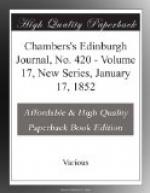Standing, then, by the statue of the Iron Duke, we have the Royal Exchange directly in front, Princes Street and the Poultry immediately behind, Lombard Street and Cornhill on the right, Threadneedle Street and Lothbury on the left hand. What an Aladin glitter seems to dance upon the paper as the names of these remarkable localities are jotted down, containing as they do so large a number of world-famous banking and commercial establishments whose operations and influence are limited only by the boundaries of civilisation! Let us look closely at one or two of the chief potentates, principalities, and powers which are there enthroned.
The Royal Exchange, it is well known, owes its origin to the public spirit of Sir Thomas Gresham, who, close upon three centuries ago, built the first Exchange upon the spot now before us. It was destroyed by fire in 1666; the next more costly erection met the same fate in 1838, and has been replaced by the present very handsome edifice. On the entablature is Her Majesty Queen Elizabeth, who inaugurated Sir Richard Gresham’s structure—the centre figure of a number of others emblematic of the all-embracing commerce of this country, and surmounted by the words: ’The earth is the Lord’s, and the fulness thereof.’ If you ascend the steps of the Royal Exchange, and pass into the body of the building, you will find a considerable number of business-looking, sleek, earnest men there, eagerly engaged in canvassing the general affairs of the world, and more especially their own particular ventures, hopes, anticipations, investments therein. If you are an artist, or indeed at all impressionable in matters of taste, you will, I fear, be painfully affected by a marble figure near the centre of the hall, which many persons assert to be a statue of the Queen of these realms—a calumny which I, as a loyal subject, feel bound most emphatically to deny. But the chief interest attached to this building is that it is here the celebrated association known as ‘Lloyd’s’ has its offices—that Lloyd’s, whose name is familiar as a household word in every country the sea touches, and who underwrite the maritime ventures




